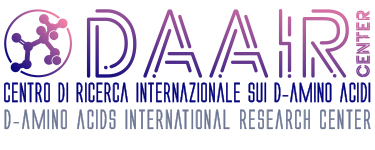D-AA in living organisms
In the beginning, D-amino acids (D-AA) have been proposed to be present in microorganisms only. During the years, D-AAs were detected in various living higher organisms, in the form of free amino acids as well as components of peptides and proteins.
Bacteria:
The major sources of D-AAs in bacteria are extracellular or periplasmic biomolecules (Radkov and Moe, 2014) such as:
– peptidoglycan (the major component of the bacterial cell wall)
– teichoic acids
– poly-γ-glutamate (containing D- and/or L-Glu, the starting material for “natto”).
Peptidoglycan (PG) – The primary mode of alteration in peptidoglycan structures is the length and composition of the inter-peptide bridge that can encompass: D-Ala, D-Glu, D-Ser, D-Asp, D-Asn, D-Lys and D-Orn. D-Ala and D-Glu may contribute to antibiotic resistance in some bacteria.
D-AAs play a role in bacterial cell wall formation during stationary phase. Distinct bacterial phyla synthesize and release different D-AAs, including D-Met and D-Leu. These D-AAs regulate cell wall remodeling in stationary phase and cause biofilm dispersal in aging bacterial communities (Lam, 2009). D-AAs in cell culture supernatant impact PG functionality through their incorporation in this network: D-AAs act as paracrine regulators in microbial communities. Bacteria release and use D-AAs to decrease cell wall formation when resources are scarce: accordingly, D-AAs help bacteria adaptation to adverse environmental conditions. Periplasmic or extracellular transpeptidases are responsible for incorporation of D-AAs into mature PG.
D-AAs have been proposed to inhibit spore germination and to be produced depending on stress response-related sigma factor RpS (in V. cholera).
Marine organisms
D-AAs have been identified in some species of bivalves as well as macro- and microalgae.
An analysis performed on 43 species in eight phyla of marine invertebrates, reported that the apparent tissue concentration ranged from 0.04 mM (in the nemertine Parborlasia corrugatus) to 44 mM (in the polycheaete Glycera dibranchiate) (Preston, 1987).
It has been postulated that marine invertebrates (e.g., crabs, shrimps, lobsters) may use D-AAs for osmoregulation and/or as a source of L-AAs under adverse conditions. D-Asp was found in all microalgae, and D-Ala was only present in the marine diatoms. D-Asp found in marine invertebrates is involved in neural transmission.
Venoms
The platypus, funnel web spider, and cone snail all have D-AAs in their venom. Isomerases in these organisms are thought to produce the D-AAs needed for the venom (Torres et al., 2006).
Plants
Analysis of D- and L-AAs in plants (leaves of coniferous and deciduous trees, fleshy fruits, leaf blades of fodder grasses, and seeds and seedlings of edible legumes) identified a free D-AA level of 0.2-8% relative to L-AAs. Many plants contain D-Asp, D-Asn, D-Glu, D-Gln, D-Ser and D-Ala and in certain plants also D-Pro, D-Val, D-Leu and D-Lys are present (Bruckner and Westhauser, 2003).
Mammals (Humans)
At the beginning of 80s, a D-AA was detected in mammals for the first time: the presence of D-Asp was demonstrated in human brains (E.H. Man et al., 1983). Later, on 1990, more D-AAs (i.e. D-Pro, D-Ala and D-Ser) were observed in other mammalian tissues using a mutant mouse strain lacking the D-AA degrading enzyme DAAO (Ohide et al., 2011; Yamanaka et al., 2012). It is believed that the source of D-AAs for humans is mainly diet (Friedman, 1999):
– D-AAs naturally occur in fresh foods; indeed, food processing, such as high heat, converts L-AAs to D-AAs
– fermented foods (e.g., bread, cheese, vinegar) are rich in D-AAs, mainly due to microbial activity
– D-AAs are absorbed by the intestine and travel to different tissues, where they are metabolized.
Among the few D-AAs found in the mammalian central nervous system, D-Asp together with D-Ser and D-Ala are the most abundant (Hashimoto and Oka, 1997). Only for D-Ser an endogenous synthesis in mammals has been demonstrated, i.e. from L-serine by the PLP-containing enzyme serine racemase. D-Ser, which is degraded by D-amino acid oxidase, is present in the brain and modulates neurotransmission. D-Asp, which is degraded by D-aspartate oxidase, is present in the neuroendocrine and endocrine tissues and testis (as well as in brain): D-Asp is involved in synthesis and secretion of hormones and spermatogenesis. D-Ser and D-Asp bind to the N-methyl-D-aspartate (NMDA) subtype of glutamate receptors and function as a coagonist and agonist, respectively. The enzymes that are involved in the synthesis and degradation of these D-AAs are associated with neural diseases where the NMDA receptors are involved. E.g., schizophrenia-affected patients showed increased cognitive function and performance when supplemented with D-Ser or D-Asp.
Indeed, D-AAs may also have analgesic (pain reduction) effects.
References
Bruckner H, Westhauser T. Chromatographic determination of L- and D-amino acids in plants. (2003) Amino Acids 24: 43-55
Friedman M. Chemistry, nutrition, and microbiology of D-amino acids. (1999) J. Agr. Food Chem. 47(9):3457-3479
Hashimoto A, Oka T. Free D-aspartate and D-serine in the mammalian brain and periphery. (1997) Prog. Neurobiol. 52(4):325-353
Yamanaka M., Miyoshi Y., Ohide H., Hamase K., Konno R. D-Amino acids in the brain and mutant rodents lacking D-amino-acids oxidase activity. (2012) Amino Acids 5:1811–1821
Lam H. D-amino acids govern stationary phase cell wall remodeling in bacteria. (2009) Science 325:1552-1555
Man E.H., Sandhouse M., Burg J., Fisher G.H.. Accumulation of D-Aspartic Acid With Age in Human Brain. (1983) Science 220:1407-1408
Ohide H., Miyoshi Y., Maruyama R., Hamase K., Konno R. – D-Amino acid metabolism in mammals: biosynthesis, degradation and analytical aspects of the metabolic study. (2011) J. Chrom. B 879: 3162-3168
Preston R.L. Occurrence of D-amino acids in higher organisms: A survey of the distribution of D-amino acids in marine invertebrates. (1987) Comp. Biochem. Physiol. 87B: 55-62
Radkov A.D., Moe L.D. Bacterial synthesis of D-amino acids. (2014) Appl. Microbiol. Biotechnol. 98:5363–5374
Torres A.M., Tsampazi M., Tsampazi C., Kennett E., Belov K., Geraghty D., Bansal P., Alewood P., Kuchel P. Mammalian L-to-D-amino-acid-residue isomerase from platypus venom. (2006) FEBS Letters 580:1587-1591
Author
Loredano Pollegioni, Università degli studi dell’Insubria
